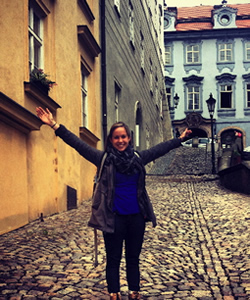Edinburgh is not the only city that has been decking the halls for some time; over the past two weeks I have traveled to Spain, the Netherlands, and Malta, and every destination has also been proudly boasting Christmas decorations. Underneath the simplicity of Christmas trees, lights, and wreaths, a greater meaning arises from these decorations. Four different countries with four very different cultures all shared the similar appreciation for the holiday season. My latest trip to Malta imparted on me the significance of these holiday decorations and the unification that this religious festivity creates for Christians across the globe.
Just off the coast of Italy in the Mediterranean, Malta is the smallest country in the European Union and thrives off of tourism. Surrounded by the majestic opal water of the Mediterranean, Malta embodies the island feel with white-washed architecture, open-air terraces, and a fantastic diet of seafood and pasta. In other words, everything that Scotland is not. Despite all of these differences, the appreciation and celebration of Christmas temporarily bridged the cultural gap between the two. Both countries are outfitted with winter decorations and have been celebrating Advent in their various churches, including the notable St. John’s Co-Cathedral in Malta and St. Giles in Scotland.
The roots of Christmas and the traditions surrounding the holiday season show how this holiday represents the ultimate unification of differences; the Christian story of Christmas comes from a combination of the Gospels of both Matthew and Luke. In fact, modern Christmas traditions stem from a variety of sources, including Jewish practices and the festivals of Druids, ancient Greeks, and Romans. The traditional figure of Santa Claus (also known as Father Christmas) varies around the world and stems from a variety of different traditions, including the Scandinavian myth of a mystical figure being pulled by reindeer and the Turkish Saint Nicholas of Myra who was the patron saint of sailors.
With this history in mind, it seems self-explanatory that despite the cultural variations, Christmas would help unify the world during the holiday season. However, it was not until I witnessed similar Christmas traditions all across Europe that I began to appreciate the true strength of the holiday season. Interestingly enough, Christmas celebrations in Scotland were subdued and quiet due to the Presbyterian influence of the Church of Scotland until 1958, when Christmas Day became a public holiday. After this, celebration increased as the church's influence decreased; today Edinburgh hosts a large Christmas market modeled after the traditional German Christmas markets.
Christmas markets in Edinburgh and Amsterdam are similar in sight, smell, and sound; both have festive holiday music playing with an abundance of sweets and knickknacks for sale. Each market proudly displays cultural specialties, ranging from nutcrackers wearing kilts to Dutch waffles dripping in chocolate, but both emulate the same festive nature. Different countries, different people, yet similar celebrations of Christmas and the winter season.
As I wrap up my travels around Europe and settle down in Edinburgh for my last two weeks of studying, I am struck by a new appreciation for Christmas and the holiday season. Despite differences in language and nationality, so many people come together this time of year to celebrate the birth of Jesus and everything the Christmas season represents. Christians around the world unite in their celebration, providing a much needed reminder of how similar people are, despite labels or geographical differences. Even those who do not practice Christianity often celebrate the festive nature of the winter holiday season and the approaching new year. The religious specifics of Christmas vary across cultures and branches of Christianity, yet the basic meaning and joy of the holiday season remains the same. And it is this joy that reminds everyone of our connection to each other, all around the globe.

